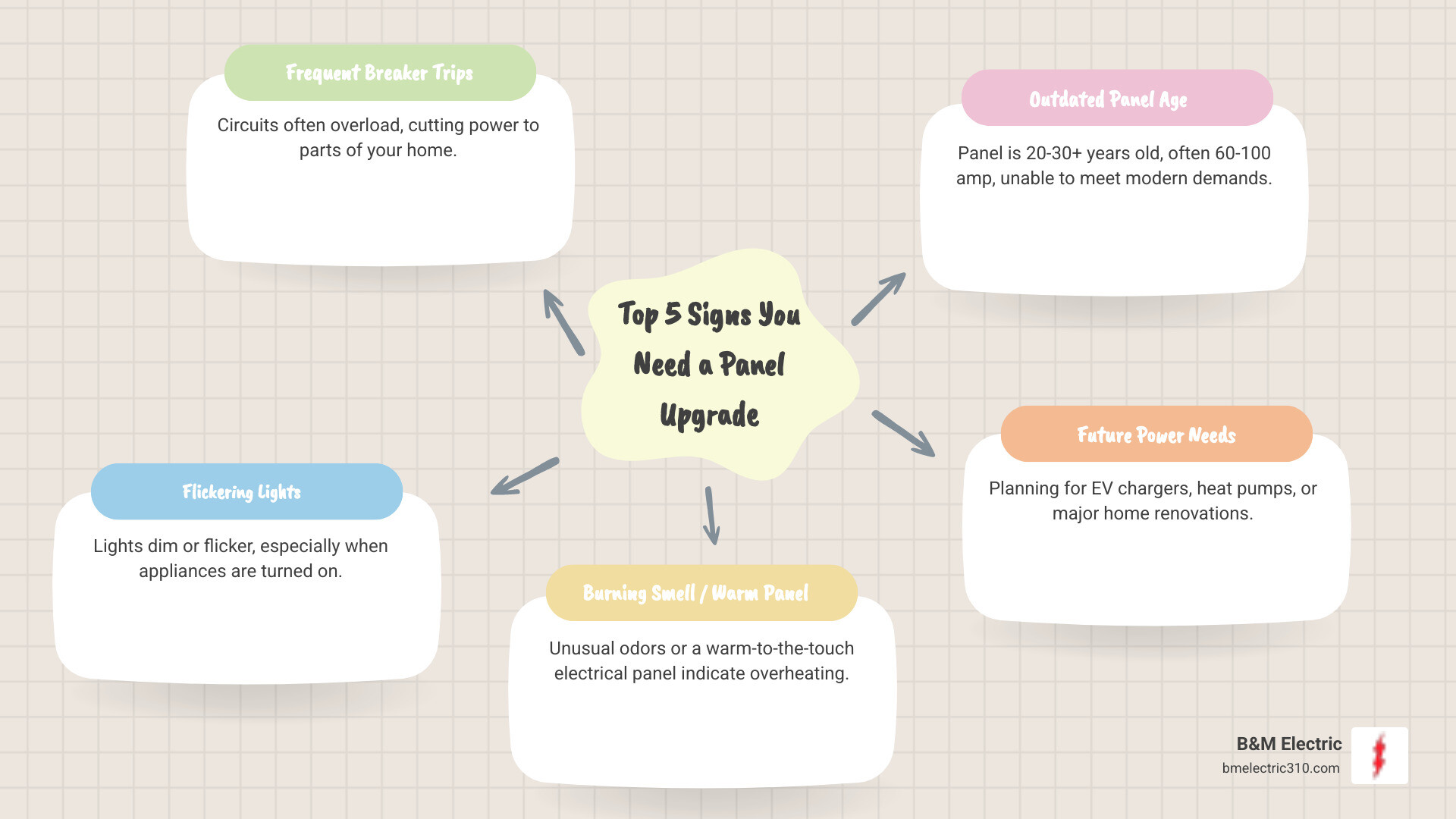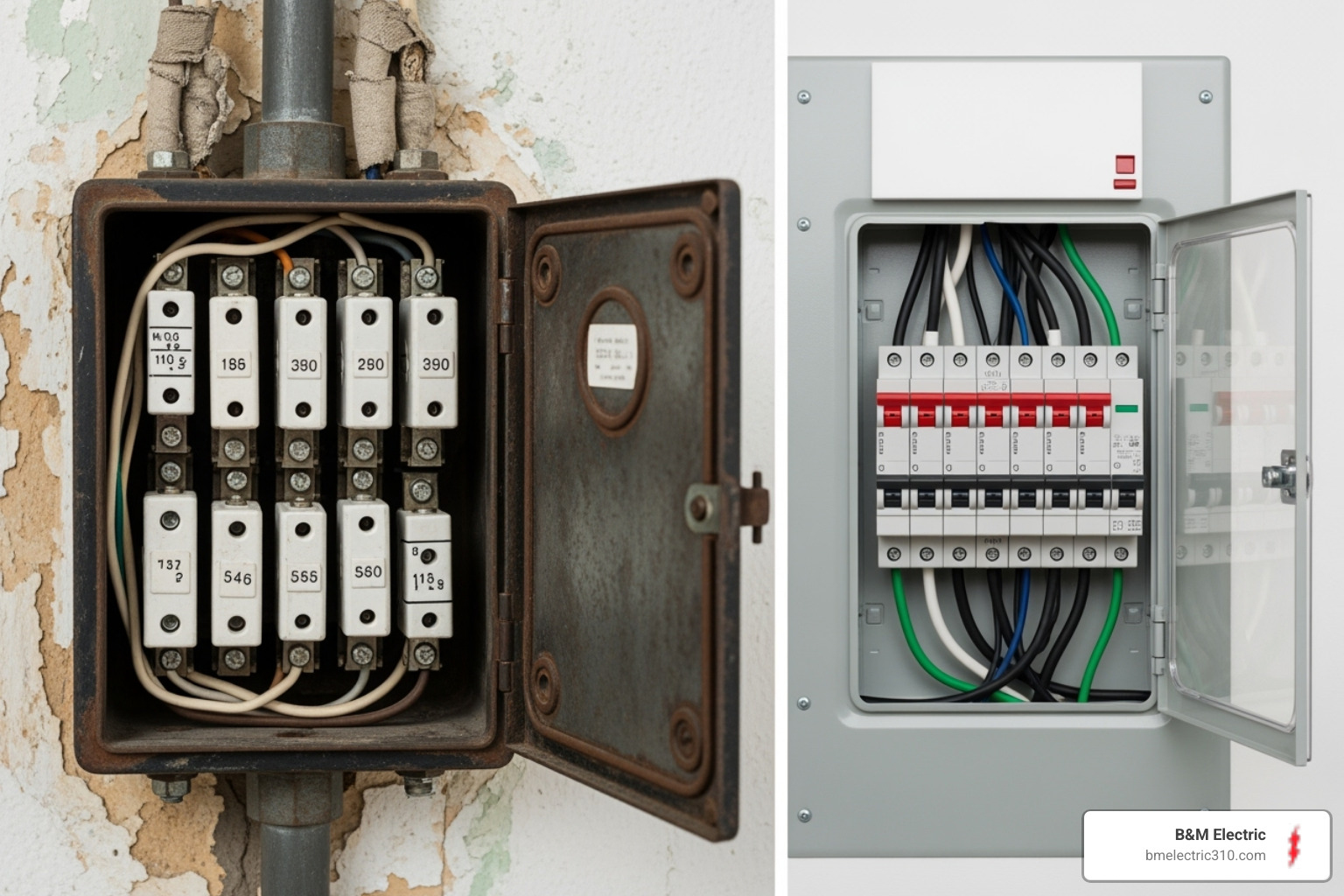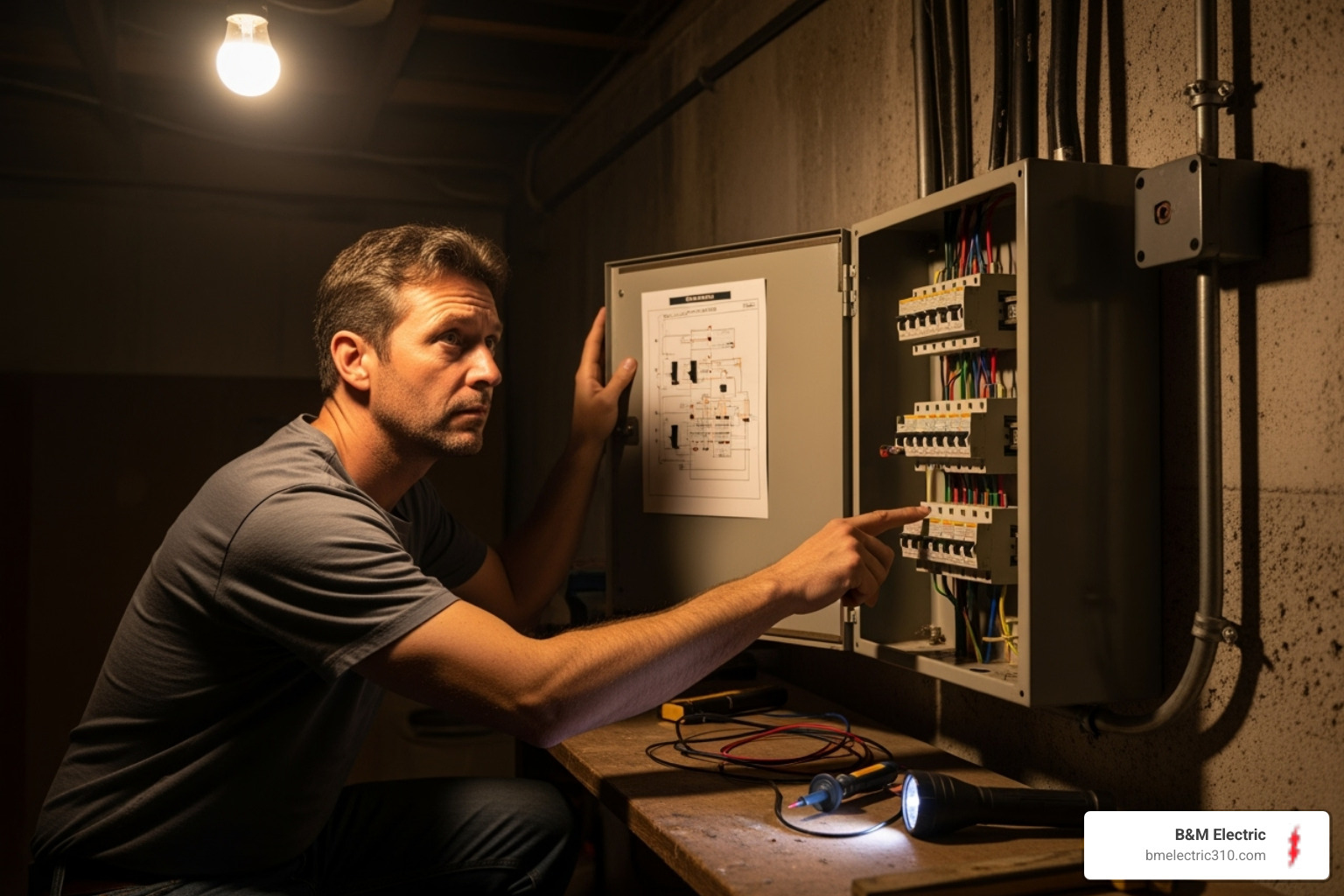From Fuse to Future: The Ultimate Guide to Upgrading Your Home’s Electrical Panel
By B&M ElectricSeptember 19, 2025
Home electrical panel upgrade: Smart & Safe 2025
Why Your Home’s Electrical Panel is the Heart of Modern Living
A Home electrical panel upgrade is essential when your current system can’t safely handle modern electrical demands, showing signs like frequent breaker trips, flickering lights, or when adding high-power appliances like EV chargers or heat pumps.
Key reasons homeowners upgrade their electrical panels:
- Safety concerns – Panels over 20-30 years old pose fire risks
- Insufficient capacity – Old 60-100 amp panels can’t power today’s homes
- Frequent power issues – Constant breaker trips and flickering lights
- Home improvements – Adding rooms, appliances, or EV charging
- Electrification – Switching to electric heat pumps, stoves, and vehicles
- Property value – Modern electrical systems increase home worth
Your electrical panel acts like the heart of your home’s power system. It takes electricity from the utility lines and distributes it safely throughout your house through individual circuits. Each circuit has its own breaker that acts as a safety switch, cutting power if there’s an overload.
Think of it this way: if your home was built decades ago, it’s trying to power today’s high-tech world with yesterday’s electrical capacity. Modern homes typically need at least 200 amps to handle multiple appliances, smart devices, and charging stations running simultaneously.
The research shows that an average of 46,700 house fires are caused by faulty electrical wiring every year. Many of these could be prevented with properly upgraded electrical panels that meet current safety standards.
Whether you’re experiencing warning signs or planning for future electrical needs, understanding when and why to upgrade your panel protects both your family and your investment.

Understanding Your Home’s Electrical Hub

Your electrical panel is the traffic controller for your home’s power, taking electricity from the utility and distributing it to various circuits. Unlike old fuse boxes that required manual replacement of blown fuses, modern circuit breaker panels are more convenient. When an overload occurs, a breaker simply trips (switches off) and can be easily reset once the issue is resolved.
The most significant difference is amperage capacity. Older homes often have 60-amp or 100-amp panels, which were sufficient for the limited electronics of the past. Today’s homes, filled with computers, smart devices, and high-power appliances, require more power. A 60-amp panel will struggle with modern demands, and even 100-amp panels can be overwhelmed by simultaneous use of an AC, laundry, and an EV charger.
For this reason, 200-amp service is now the standard for new construction, providing enough capacity for current and future needs. Many Common Circuit Breaker Problems arise from undersized panels.
What is an Electrical Panel?
Often called a main breaker box, fuse box, or service panel, this metal box is your home’s power distribution hub and a critical safety device. Each circuit is protected by a breaker that cuts power instantly during a fault, preventing wires from overheating and causing fires. This is why proper Electrical Maintenance Explained is vital for safety.
Amperage Sizes and Your Home’s Needs
Choosing the right amperage is about future-proofing your home. We perform a detailed load calculation to assess your total electrical needs. While a small home might seem fine with 100-amp service, this capacity is easily outgrown. Large homes with multiple high-draw areas almost always require 200-amp service.
High-demand appliances like EV chargers, hot tubs, or central air conditioning significantly increase your electrical load. Adding them to an older system often leads to frequent breaker trips and dimming lights. As home electrification (switching to electric heat pumps, stoves, and vehicles) becomes more common, the need for high-capacity service grows. Upgrading is often the best way of Resolving Overloaded Electrical Panels to safely support a modern lifestyle.
Key Signs You Need a Home Electrical Panel Upgrade

Your home’s electrical system will often show signs of strain before a major issue occurs. Recognizing these warnings is key to maintaining a safe home. Common indicators include:
- Burning Smell or Warmth: A burning odor or a panel that’s warm to the touch signals overheating and requires immediate professional attention.
- Odd Noises: Buzzing or crackling sounds from the panel often point to loose connections or failing components.
- Flickering Lights: If lights dim or flicker when a large appliance turns on, your system is struggling to provide consistent power.
- Frequent Breaker Trips: While breakers are a safety feature, constantly resetting them indicates an overloaded system. This is one of the most common Frequent Circuit Breaker Trips.
- Age: Panels over 20-30 years old were not designed for modern electrical loads and may lack current safety features.
- Renovations or New Appliances: Adding a room, a hot tub, or a modern kitchen will likely exceed your current panel’s capacity. A full list of indicators can be found in our guide to the Signs You Need an Electrical Panel Upgrade.
Dangerous and Obvious Warning Signs
Some signs demand immediate action. An overheating panel, crackling noises (indicating arcing), melted wiring, or visible rust and corrosion are all urgent fire hazards. These issues compromise your system’s safety and will only worsen over time. Some older panel brands also have known design flaws that make them prone to failure, making a professional assessment crucial if you experience any electrical problems.
Preparing for the Future: Electrification and Remodels
The move toward home electrification—switching to electric appliances for efficiency—makes a panel upgrade essential.
- EV Charging: A Level 2 charger adds a significant electrical load, often requiring a panel evaluation. Our EV Charging at Home services always begin with this assessment.
- Heat Pumps and Induction Stoves: These efficient appliances require dedicated circuits and substantial power that older panels cannot safely provide.
- Remodels: Major renovations like finishing a basement or updating a kitchen almost always require more power and circuits. Our Home Remodel Electrical Installation Services ensure your new space is properly and safely powered.
Planning ahead and upgrading your panel proactively is more cost-effective and ensures your home is ready for future technology.
The Benefits of Upgrading Your Electrical Panel

Picture this: you walk into your kitchen on a busy morning, start the coffee maker, turn on the microwave, and flip the lights on—all without a single flicker or worry about a breaker tripping. That’s the peace of mind that comes with a Home electrical panel upgrade.
When we talk to homeowners in Torrance about upgrading their electrical panels, we’re really talking about changing their daily lives. It’s not just about replacing an old metal box in your garage or utility room. You’re investing in improved safety for your family, increased capacity for all your modern gadgets, and improved system reliability that keeps your home running smoothly.
Think about how much your electrical needs have changed over the years. Your home now powers smartphones, tablets, smart TVs, gaming systems, and maybe even an electric vehicle. A modern electrical panel handles all of this effortlessly, providing the increased capacity you need without the constant worry of overloaded circuits.
But perhaps most importantly, you’re dramatically improving your home’s resale value. When potential buyers see a recently upgraded electrical system, they see a home that’s been well-cared for and won’t require immediate electrical work. Real estate agents often tell us that updated electrical systems are among the top features buyers look for. Our detailed insights on The Impact of Electrical Upgrades on Home Resale show just how significant this investment can be.
A new panel also brings energy efficiency improvements. While the panel itself doesn’t use less electricity, it ensures your entire system operates more efficiently, preventing the power loss that often occurs with overloaded or outdated components.
Improving Home Safety and Reducing Fire Risk
Here’s where things get serious. Every year, faulty electrical systems cause thousands of house fires across the country. Many of these tragedies could be prevented with properly functioning, up-to-date electrical panels.
Older panels simply weren’t designed for today’s electrical demands. When you push them beyond their limits, they can overheat, create dangerous electrical arcs, or fail to properly protect your circuits. It’s like asking a 1960s car engine to perform like a modern sports car—eventually, something’s going to give.
Modern panels come equipped with advanced safety features that older systems lack. AFCI protection (Arc Fault Circuit Interrupters) detects dangerous electrical arcs that can spark fires, while GFCI protection (Ground Fault Circuit Interrupters) prevents electrical shocks, especially in wet areas like bathrooms and kitchens.
These aren’t just nice-to-have features—they’re required by current code compliance standards for good reason. The Data on electrical fires from the NFPA shows us exactly why these safety measures matter so much. We always emphasize Electrical Safety Tips in every upgrade we perform.
What are ‘Smart Panels’?
Welcome to the future of home electrical systems. Smart panels represent the cutting edge of electrical technology, bringing intelligent energy management right to your fingertips.
Imagine being able to monitor exactly how much power your air conditioner uses compared to your electric dryer. With remote monitoring capabilities, you can check your home’s electrical usage from anywhere using your smartphone. Some systems even allow circuit-level control, letting you turn specific circuits on or off remotely.
This isn’t just cool technology for tech enthusiasts. Smart panels excel at managing modern homes with solar panels, battery storage systems, and electric vehicle chargers. They optimize energy flow automatically, ensuring you get the most efficiency from your renewable energy investments.
While smart panels are still relatively new to many homeowners, they represent the future of home power. They combine all the safety and capacity benefits of a traditional panel upgrade with intelligent features that help you understand and control your energy usage like never before.
At B&M Electric, we’ve seen how these upgrades transform our customers’ relationship with their home’s electrical system—from constant worry to complete confidence.
The Upgrade Process: From Assessment to Power-On
A professional Home electrical panel upgrade is a well-orchestrated process. Our approach ensures a seamless experience from start to finish.
- Professional Assessment: A licensed
[Electrician](https://bmelectric310.com/electrician/)examines your current system, evaluates wiring, and performs a load calculation to determine the correct panel size for your needs. - Permitting: We handle all the necessary paperwork with local authorities to ensure your upgrade is fully compliant with building codes.
- Installation & Utility Coordination: On installation day, power is temporarily disconnected. Our team removes the old panel and installs the new one. For amperage increases, we coordinate with the utility company to upgrade the service line and meter if needed.
- Final Inspection: A municipal inspector reviews the completed work. Power is fully restored only after the project passes this final safety check, which is why
[Electrical Inspections: Safeguarding Home](https://bmelectric310.com/blog/electrical-inspections-safeguarding-home/)are so critical.
Why You Must Hire a Professional
Electrical panel work is not a DIY project. The high voltage risks are severe, as wires from the utility remain live even when the main breaker is off, posing a lethal threat. Professionals are trained to steer these dangers safely.
Furthermore, licensed electricians understand the complex National Electric Code (NEC) and local building codes, ensuring the work passes inspection and is safe. Most insurance companies will not cover damages from unlicensed electrical work. Hiring a professional ensures the job is done correctly and safely, providing peace of mind and reliable [Electrical Repairs for a Safe Home](https://bmelectric310.com/blog/electrical-repairs-for-a-safe-home/).
Panel Upgrade vs. Replacement
While often used interchangeably, these terms have different meanings.
| Feature | Panel Upgrade | Panel Replacement |
|---|---|---|
| Primary Goal | Increase electrical capacity (amperage) | Replace an old/faulty panel with similar capacity |
| Amperage Change | Typically from 60/100A to 200A (or higher) | Stays same (e.g., 100A to new 100A) |
| Scope of Work | New panel, often new service cable, meter socket | New panel, potentially new breakers |
| Utility Involvement | Often required for service upgrade | Less likely, unless service is also problematic |
| Purpose | Accommodate new load, future-proof, improve safety | Restore functionality, modernize old equipment |
A panel replacement is a like-for-like swap to replace a faulty unit. A panel upgrade increases your home’s total electrical capacity, often from 100A to 200A. An upgrade is a more extensive project but is what most homes need to handle modern electrical loads and address issues with [Outdated Electrical Panels](https://bmelectric310.com/blog/outdated-electrical-panels/).
Frequently Asked Questions about Panel Upgrades
We understand that a Home electrical panel upgrade is a significant decision for any homeowner. After 50 years of serving families in Torrance and the South Bay, we’ve heard just about every question you can imagine. Here are the ones that come up most often, along with our straightforward answers.
How can I tell if my current electrical panel is sufficient?
The honest answer? It’s tough to know for sure without professional eyes on it. But there are some telltale signs you can spot yourself that’ll give you a pretty good idea.
First, check the amperage rating on your main circuit breaker – it’s usually the biggest breaker in your panel. You’ll see a number like “60,” “100,” or “200” followed by “A” or “Amps.” If you’re looking at 100 amps or less and you’ve got a modern home with all the usual suspects (electric stove, dryer, central AC, maybe a hot tub), you’re probably pushing the limits.
Next, assess your appliance load honestly. Do you find yourself strategically timing when you run the dishwasher so it doesn’t trip a breaker when the AC kicks on? That’s your electrical system waving a white flag. And if you’re planning to add an EV charger, heat pump, or any other power-hungry addition, your current setup might not have the muscle for it.
Observe your home’s performance too. Flickering lights when appliances start up, breakers that trip more often than a clumsy person on a hiking trail, or appliances that seem sluggish – these are all your panel’s way of saying “help me.”
Don’t forget to consider future additions. Even if everything seems fine today, will your panel handle tomorrow’s plans? A professional load calculation is really the gold standard for knowing if your [Electrical Panel Needs an Upgrade?](https://bmelectric310.com/blog/electrical-panel-needs-an-upgrade/)
How does a service upgrade from the utility relate to a panel upgrade?
Think of it like this: if your electrical panel is the heart of your home’s power system, then the utility service is the main artery feeding it. When you upgrade to a higher amperage panel (say, from 100 to 200 amps), that main artery often needs to get bigger too.
Here’s what typically happens: The service drop (that’s the wire bringing power from the utility pole or underground transformer to your house) might need upgrading. The weatherhead (where that wire connects to your home) and your electric meter also need to handle the increased capacity.
It’s actually a pretty coordinated dance. Your electrician will work with the utility company to make sure everything on their end can support your upgrade. Sometimes they’ll need to swap out their equipment, and sometimes you’ll need to upgrade the service mast and meter socket on your property.
The good news? We handle all the coordination for you. It’s all part of ensuring your home has the robust [Electrical Service](https://bmelectric310.com/electrical/) it needs for modern living.
Are there tax credits for a home electrical panel upgrade?
Yes, and it’s one of the better-kept secrets of home improvement! Thanks to the Inflation Reduction Act from 2022, there are some nice energy efficiency incentives available for homeowners.
A Home electrical panel upgrade can qualify for a federal tax credit of 30% of the project cost, with a maximum credit of $600. The catch? It generally needs to be installed alongside other qualifying energy-efficient improvements like heat pumps or EV charging stations.
Here’s how the numbers work: There’s an overall annual limit of $3,200 for efficiency tax credits. Within that, you can claim up to $1,200 for home envelope improvements (which includes electrical upgrades) combined with furnaces, boilers, and central air conditioners. Heat pumps and similar equipment have their own separate $2,000 annual limit.
These credits are available for equipment purchased and installed between January 1, 2023, and December 31, 2025. For the full details and to make sure you qualify, check out the official [Federal tax credits for panel upgrades](https://www.energystar.gov/about/federal-tax-credits/electric-panel-upgrade) information from Energy Star.
It’s definitely worth exploring – every little bit helps when you’re investing in your home’s safety and future!
Conclusion
A Home electrical panel upgrade represents one of the smartest investments you can make in your home’s future. It’s not just about fixing what’s broken—it’s about creating a foundation that keeps your family safe while powering everything from your morning coffee maker to your electric vehicle charger.
Throughout this guide, we’ve explored how an aging or undersized panel creates real problems: flickering lights that interrupt your evening movie, breakers that trip right when you’re hosting dinner, and worst of all, the hidden fire risks that keep us electricians up at night. But we’ve also seen the incredible change that happens when you upgrade to a modern system.
The benefits extend far beyond convenience. Your upgraded panel becomes a safety guardian, protecting your family with advanced AFCI and GFCI technology. It provides the robust capacity needed for today’s energy-hungry appliances and tomorrow’s exciting technologies like smart home systems and EV chargers. Plus, it adds real value to your property—something potential buyers immediately notice and appreciate.
The shift toward home electrification makes this upgrade even more critical. Whether you’re considering a heat pump for efficient heating and cooling, an induction cooktop for precise cooking, or an EV charger for your driveway, your electrical panel needs to be ready. An outdated 60 or 100-amp system simply can’t handle these modern demands safely.
This isn’t a weekend DIY project. Working with high-voltage electricity requires specialized training, proper tools, and deep knowledge of ever-changing electrical codes. One mistake can be deadly, and insurance companies know this—they won’t cover damage from unlicensed electrical work.
At B&M Electric, we’ve been helping Torrance families steer these upgrades for five decades. We understand that inviting someone into your home to work on something as vital as your electrical system requires trust. That’s why we focus on clear communication, meticulous work, and treating every home like it’s our own.
Your home deserves an electrical system that works as hard as you do—reliably, safely, and efficiently. When you’re ready to give your family the peace of mind that comes with a modern electrical foundation, [Schedule your electrical panel upgrade in Torrance, CA](https://bmelectric310.com/electrical/torrance-ca/electrical-panels/) with our experienced team.